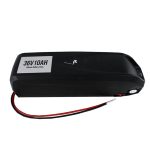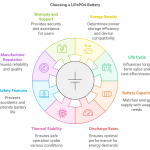
Solar energy is a fantastic way to get power anywhere the sun shines. It works great but only when the sun is out, so it’s critical to have the best battery possible for storing solar energy. LiFePO4 battery chemistry is one of the best options for solar storage for a number of reasons.
Join us as we take a closer look at the best option for storing the sun’s energy.
What Is Solar Battery Storage?
First, let’s simply define solar battery storage. Solar panels convert sunlight into energy, but you can’t always count on having enough sunlight to provide consistent power on demand. If it’s overcast or nighttime, you’d be out of luck without a good battery.
When the solar panels absorb the power, it is transferred to the battery until it reaches capacity. You can use the power stored within when it’s overcast or night and rely on fresh solar power when it’s sunny. The battery can also provide a larger amount of energy for a short period of time. It is possible to run a 1200 watt microwave on a 300-watt solar panel, but only if you have a batter to store and provide the larger amount of energy for a shorter period.
The battery is the heart of the solar system because none of the other components are much help without it.
Solar Battery Storage Options
As you might have gathered from the title, LiFePO4 is our top choice and what we specialize in at dragonfly energy. It stands head and shoulders above traditional lead-acid batteries of all types, and we consider it the best lithium battery option for solar.
Here are a few of the most common types of solar battery storage options
Lead-Acid Batteries
Lead-acid batteries are likely the most familiar type that can be used for storage. The vast majority of gas-powered passenger vehicles operate with a lead-acid battery to power the starter and other electrical components.
The battery chemistry is tried and true, having been around for generations. It’s easy to find, and they tend to be less expensive than lithium options. There are many different types of lead-acid such as flooded, Gel, AGM, or crystal but they all perform similarly for storage.
While lead-acid is less expensive upfront, there are many drawbacks to solar storage. Chief among these is their usable capacity; you can only discharge them to 50% before they suffer damage. They also last for many fewer life cycles than lithium batteries. Charge rates are also slower and they suffer damage when not fully recharged properly a common occurrence with solar energy systems.
Lithium-Ion Batteries
As mentioned, lithium batteries, like LiFePO4, have a more advanced chemical makeup. Though they’re generally more expensive upfront, lithium batteries have proven their worth over the years in both small applications like cameras and cell phones as well as in large appliances and vehicles.
Lithium batteries store more energy, put out more power and deliver a more consistent supply, and last longer, particularly compared to lead-acid batteries. Charging can start and stop anywhere in the charge cycle and they last thousands of more cycles than lead-acid.
The initial cost is the biggest drawback of lithium batteries. They can be much more expensive initially, but it pays off in the long run. We guarantee our LiFePO4 battery to last 5 years, but they normally last much longer.
Lithium-ion batteries can boast different kinds of chemistry based on the application. Regarding solar battery storage, LiFePO4 (lithium iron phosphate) has a battery chemistry that stands out above both lead-acid and other lithium batteries.
LiFePO4 batteries are widely considered the safest type of lithium battery, and they last for a decade or longer. They also offer flexible charging and deeper discharge cycles without damage.


